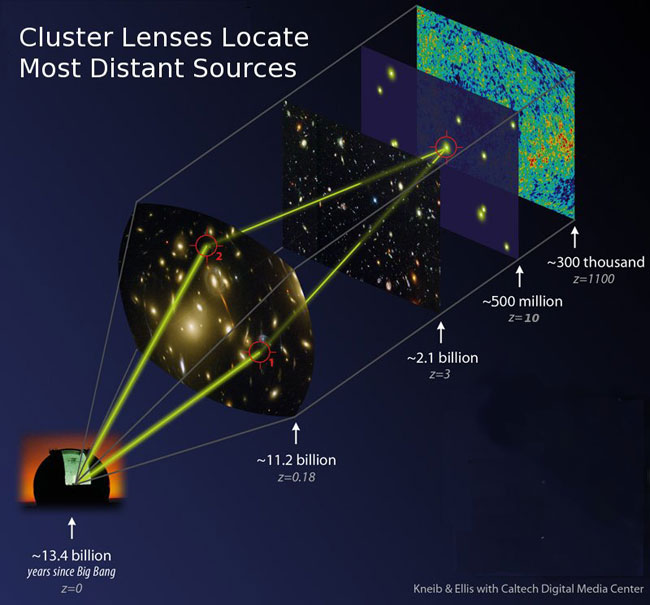Astronomers Find Farthest Known Galaxies

Astronomers have found evidence for the most distant galaxies ever detected.
The galaxies are seen as they existed just 500 million years after the birth of the universe. Their light, traversing the cosmos for more than 13 billion years, was seen only because it was distorted in a natural "gravitational lens" created by the gravity-bending mass of a nearer cluster of galaxies.
"Gravitational lensing is the magnification of distant sources by foreground structures," explained Caltech astronomer Richard Ellis, who led the international team. "By looking through carefully selected clusters, we have located six star-forming galaxies seen at unprecedented distances, corresponding to a time when the universe was only 500 million years old, or less than 4 percent of its present age."
The universe is estimated to be 13.7 billion years old, so that puts the newfound galaxies at 13.2 billion light-years away. A light-year is the distance light travels in a year, about 6 trillion miles (10 trillion kilometers).
Tricky technique
The team found the galaxies using the 10-meter Keck II telescope atop Mauna Kea on the Big Island of Hawaii. The finding will be presented tomorrow at a conference of the Geological Society in London.
The light from the half-dozen faraway star-forming galaxies was boosted about 20 times by the magnifying effect of the foreground galaxy cluster, said team member Dan Stark, a Caltech graduate student.
Breaking space news, the latest updates on rocket launches, skywatching events and more!
Gravitational lensing is tricky, the researchers admit. To bolster their case, they point to very ancient galaxies that are just slightly closer, yet which already contain old stars.
"To produce these old stars requires significant earlier activity, most likely in the fainter star-forming galaxies we have now seen," Stark said.
In 2004, a separate team claimed discovery of a galaxy 13.23 billion light-years away, "but re-examination of that object by others showed it to be spurious," Stark told SPACE.com today.
End of the Dark Ages
The galaxies offer a glimpse of an era shortly after the first stars formed.
After the theoretical Big Bang, there were no stars. Eventually, a thick "fog" was effectively burned off by hot, young stars, ending what's called the cosmic Dark Ages.
"That we should find so many distant galaxies in our small survey area suggests they are very numerous indeed," Stark said. "We estimate the combined radiation output of this population could be sufficient to break apart (ionize) the hydrogen atoms in space at that time, thereby ending the Dark Ages."
- Video: Our Corner of the Cosmos
- The Strangest Things in Space
- Top 10 Star Mysteries

Rob has been producing internet content since the mid-1990s. He was a writer, editor and Director of Site Operations at Space.com starting in 1999. He served as Managing Editor of LiveScience since its launch in 2004. He then oversaw news operations for the Space.com's then-parent company TechMediaNetwork's growing suite of technology, science and business news sites. Prior to joining the company, Rob was an editor at The Star-Ledger in New Jersey. He has a journalism degree from Humboldt State University in California, is an author and also writes for Medium.
